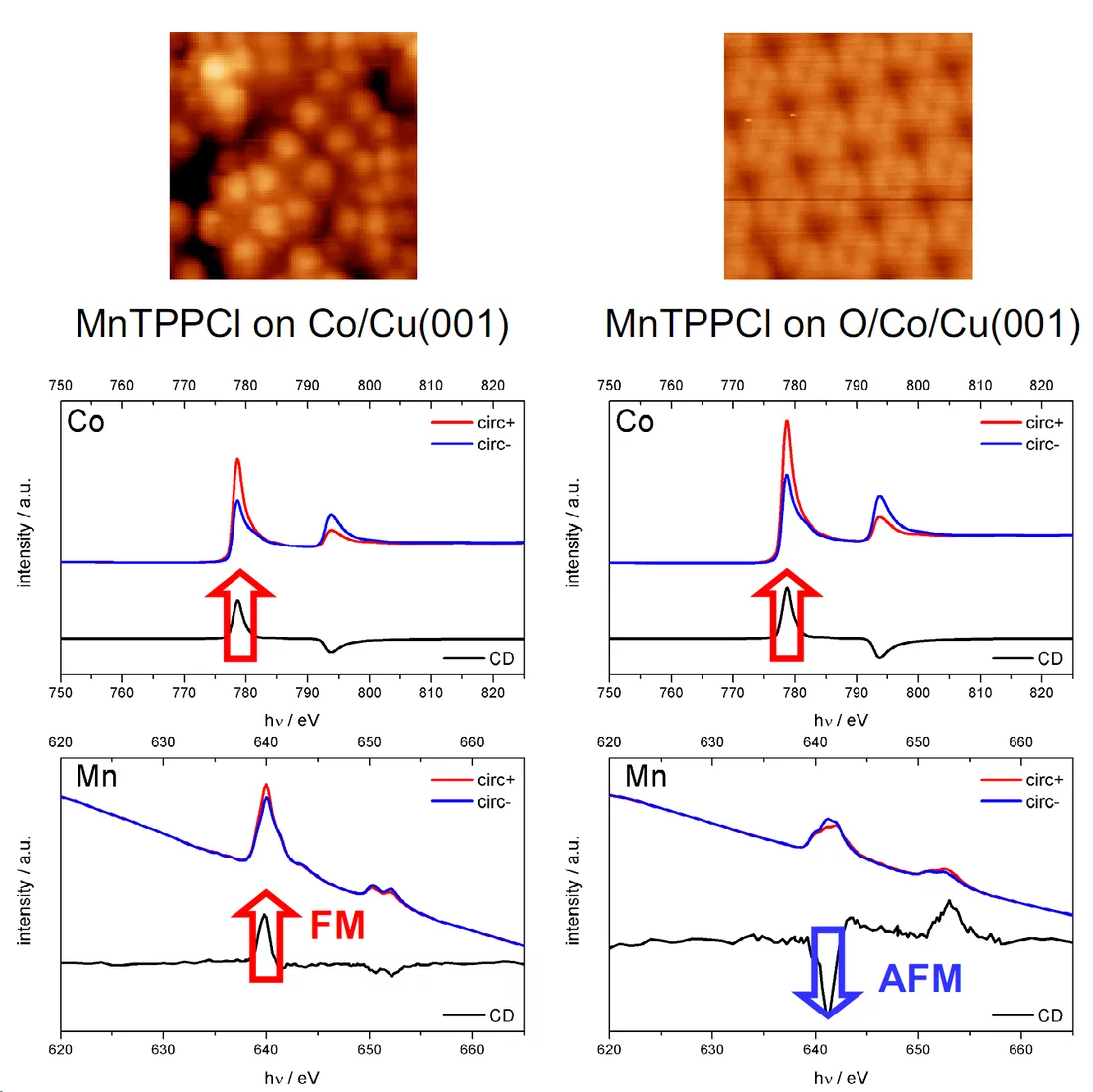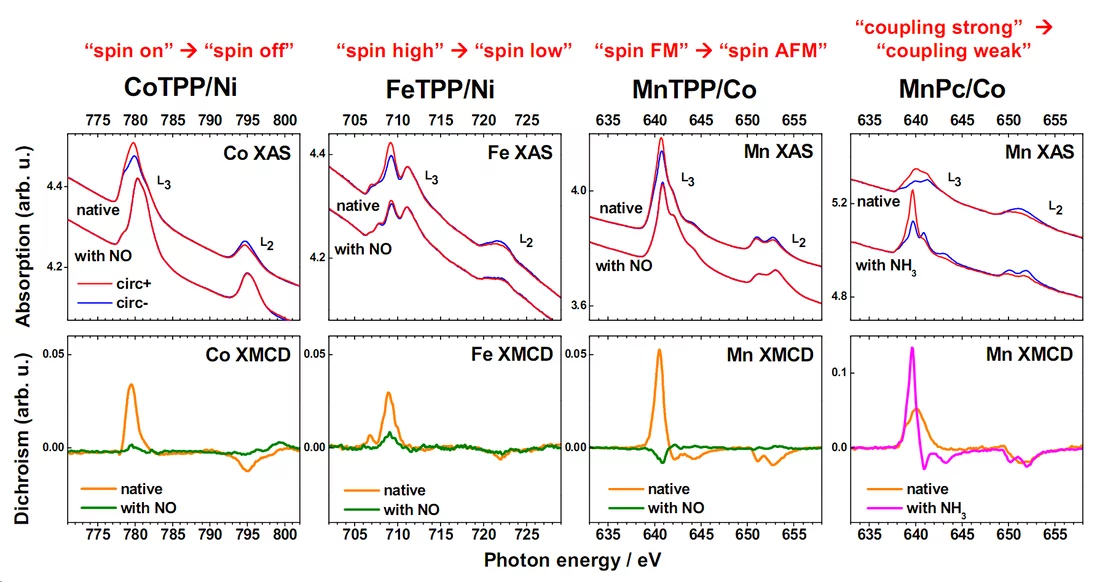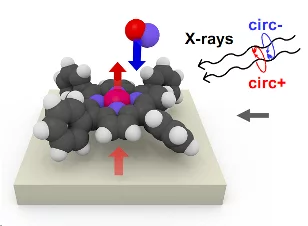The possibility to use organic compounds at surfaces to create specific, also low-dimensional architectures containing quantum wells and spin bearing atoms opens up new opportunities. This in particular as they allow for the programming of the assembly and for the often-precise modification of their properties by chemical substitution. To advance towards versatile quantum materials and to explore future quantum devices with decreasing characteristic dimension and increasingly well-defined contacts/gates the understanding of the electronic and magnetic coupling within these architectures is of utmost importance.
Our pioneering work showed that monolayers of organic paramagnetic molecules can couple both ferromagnetically [1, 2] and antifer‐ romagnetically [3] to the underlying ferromagnetic surfaces depend‐ ing on their electronic structure. If sublimed onto an oxygen‐ reconstructed ferromagnetic substrate, the molecules are coupled antiferromagnetically with respect to the substrate [4]. Furthermore, we find that the oxygen‐reconstruction allows for the self‐assembly of the ad‐molecules. This recipe has been used to create the first 2 dimensional ferrimagnetic sheet as proven by T-dependent X-ray magnetic circular dichroism experiments at the Swiss Light Source and complementary Scanning Tunneling Microscopy/Spectroscy at varied low Temperatures [6].
The magnetic moments in the ad‐molecules and in the ferromag‐ netic substrates are determined by the element specific X‐ray mag‐ netic circular dichoism (XMCD) technique. The XMCD experiments are performed at the Swiss Light Source (SLS) in collaboration with the Microscopy and Magnetism Group on samples which are pre‐ pared and characterized in our Surface Science Lab. Thus, we employ a combination of local (Scanning Tunneling Microscopy) with spatially averaging (X‐ray photoelec‐ tron spectroscopy, X‐ray absorption, XMCD) techniques. The experiments are complemented by den‐ sity functional theory (DFT+U) calculations performed by Peter Oppeneer and co‐workers (University of Uppsala). On the basis of possibility to induce a magnetic moment into molecular complexes, we explore the "spin off" [5].
We find that, if applied to those on‐surface complexes, coordination of the external stimulus can also
i) tune the spin ("spin high" to "spin low"), ii) change the sign of the exchange coupling ("spin FM" to spin "AFM") and iii) adjust the strength of the exchange coupling ("coupling strong" to "coupling weak"). In consequence to the "trans effect", we the observed magnetochemical effects provide evi‐ dence for the existence of a "surface spin trans effect".
Publications
[1] Induced magnetic ordering in a molecular monolayer
A. Scheybal, T. Ramsvik, R. Bertschinger, M. Putero, F. Nolting, et al.
Chem. Phys. Lett. 411, 214 (2005)
[2] Indirect magnetic coupling of manganese porphyrin to a ferromagnetic cobalt substrate
D. Chylarecka, T. K. Kim, K. Tarafder, K. Müller, K. Gödel, et al.
J. Phys. Chem. C 115, 1295 (2011)
[3] Antiferromagnetic coupling of Cr-porphyrin to a bare Co substrate
J. Girovsky, K. Tarafder, C. Waeckerlin, J. Nowakowski, D. Siewert et al.
Phys. Rev. B 90, 220404 (2014)
[4] Self-assembly and superexchange coupling of magnetic molecules on oxygen-reconstructed ferromagnetic thin film
D. Chylarecka, C. Wäckerlin, T. K. Kim, K. Müller, F. Nolting, et al.
J. Phys. Chem. Lett. 1, 1408 (2010)
[5] Controlling spins in adsorbed molecules by a chemical switch
C. Wäckerlin, D. Chylarecka, A. Kleibert, K. Müller, C. Iacovita, et al.
Nature Comm. 1, 61 (2010)
[6] Long-range ferrimagnetic order in atwo-dimensional supramolecular Kondo lattice
J. Girovsky et al,
Nature Comm. 10.1038/ncomms (2017)
[7] On-surface coordination chemistry of planar molecular spin systems: novel magnetochemical effects induced by axial ligands
C. Wäckerlin, K. Tarafder, D. Siewert, J. Girovsky, T. Hählen, et al.
Chem. Sci. doi:10.1039/c2sc20828h (2012)




